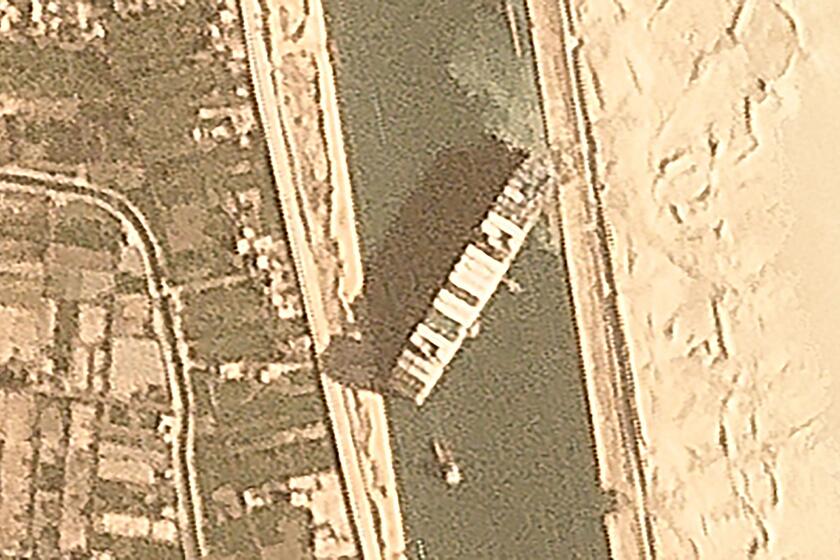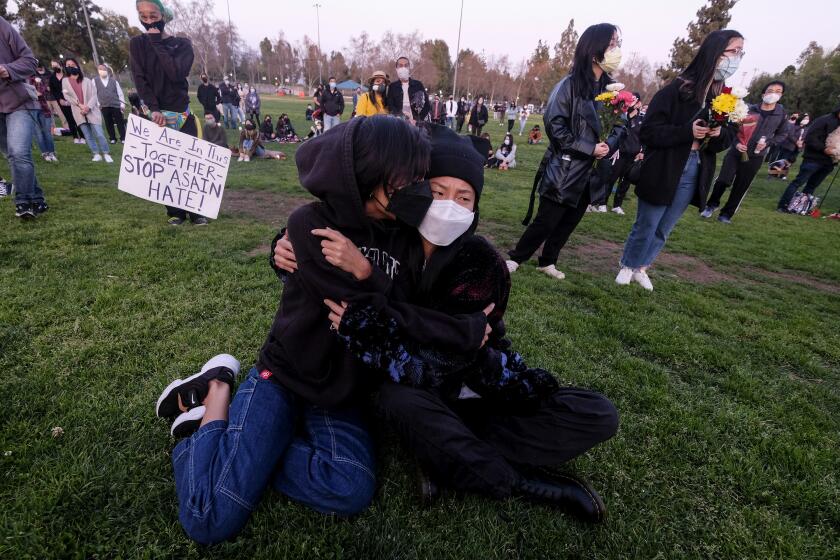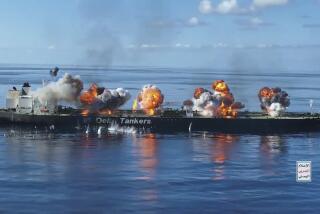Dredgers try to free ship in Suez Canal, scene of plenty of past international drama
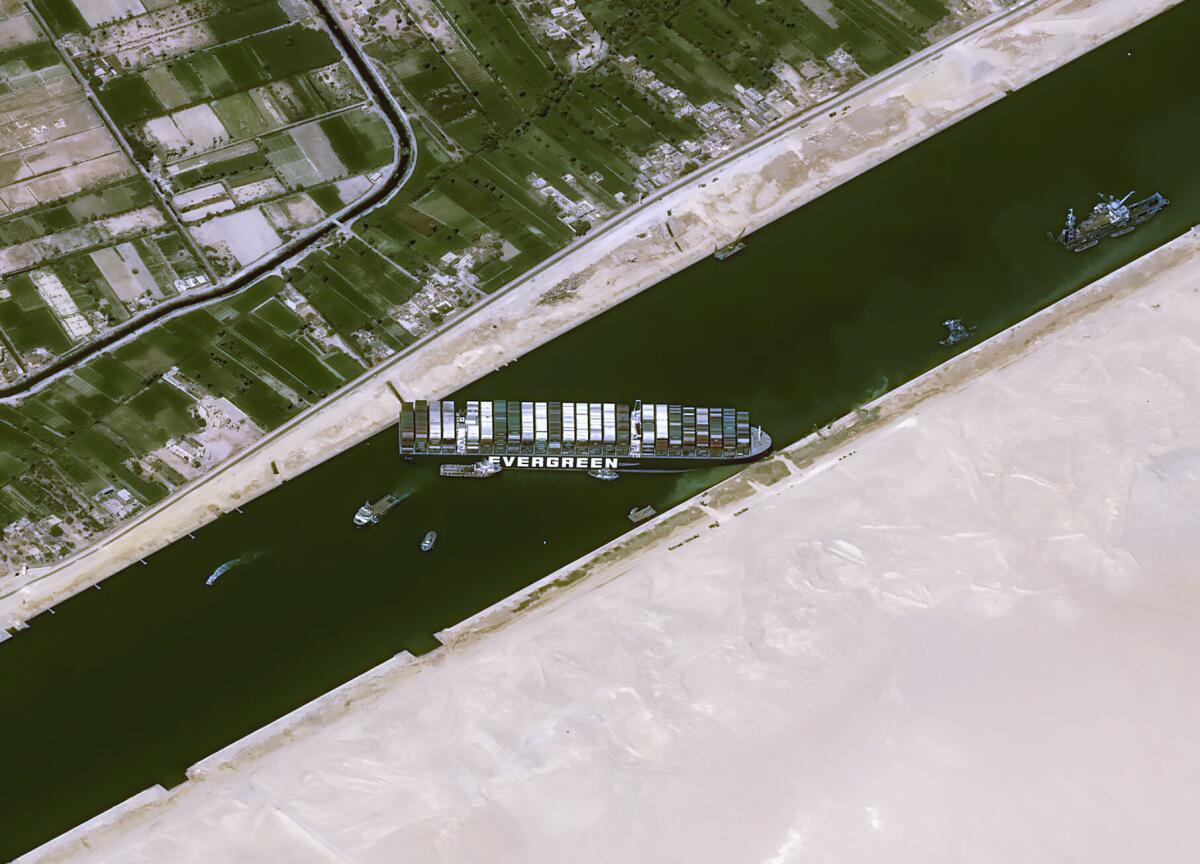
- Share via
BEIRUT — With the global supply chain in jeopardy, powerful tugboats and dredgers worked desperately Friday to free the giant cargo ship blocking the Suez Canal in a race against mounting economic losses.
Hundreds of ships have been left waiting in the open sea, tens of billions of dollars’ worth of goods lie undelivered and companies the world over are grappling with the possibility of a protracted closure of a waterway through which one-tenth of global shipping passes. There were reports Friday that some companies were already diverting ships away from the Egyptian canal, but they faced a much longer journey around Africa.
The Ever Given, a 1,312-foot-long, 200,000-ton behemoth, beached itself in the canal early Tuesday during a sandstorm. On Friday, dredgers capable of shifting more than 70,000 cubic feet of material per hour and teams of excavators were trying to dislodge the ship, said GAC, a shipping agent at the canal.
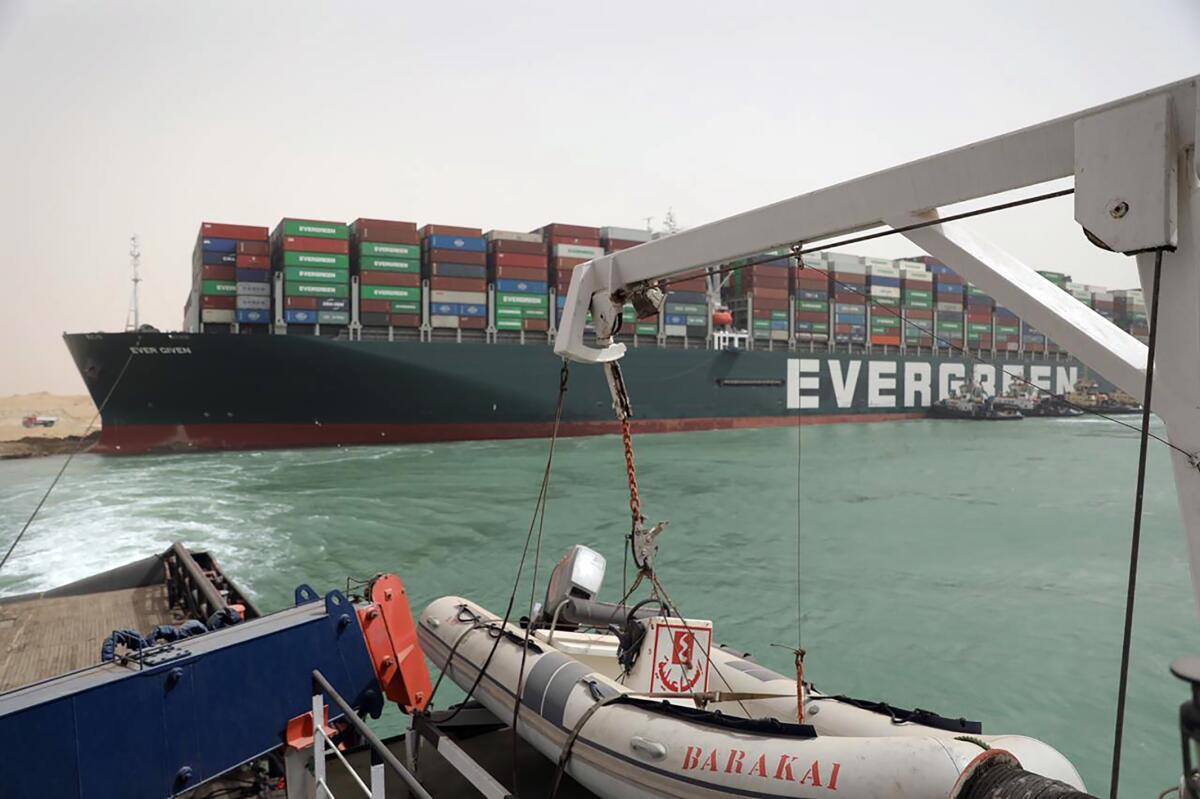
“There is still no confirmed progress reported,” the company said in a statement, adding that the next attempt to refloat the ship is expected at high tide Friday evening.
About 90% of the world’s goods ply the oceans, and the plugged artery demonstrates how a single incident can disrupt “the finely balanced system that we all rely on,” Guy Platten, secretary general of the International Chamber of Shipping, said in a statement Thursday.
The drama is not the first in the history of the 120-mile Suez Canal, which has been the backdrop of tales of glory, empire and international power games.
A cargo ship has been wedged in the Suez Canal for two days, sealing off the waterway in a crisis that could have major consequences for global trade.
The idea for a passageway linking the Red Sea to the Mediterranean was around well before the canal was built more than 151 years ago. Pharaoh Senusret III ordered a canal dug between the two seas via parts of the Nile and its branches as early as 1874 BC, according to the Suez Canal Authority. That channel underwent several expansions and iterations over the centuries, but was then largely forgotten until Ferdinand de Lesseps, a French diplomat who served as vice consul to Alexandria in 1832, took an interest.
De Lesseps befriended the viceroy of Egypt, Muhammad Ali, and his 13-year-old son, Said Pasha. Muhammad Ali considered his son both indolent and corpulent, and put the boy on a strict regimen of diet and exercise that involved walking around a vessel in Alexandria, not far from De Lesseps’ home. Presumably out of sympathy, the Frenchman would sneak plates of spaghetti — some versions of the story call it macaroni — to Said Pasha.
The pasta diplomacy served De Lesseps well more than 20 years later, when Said Pasha became viceroy and the now-retired diplomat asked for and received the exclusive concession to construct the modern canal.
It came at a massive human cost: thousands of Egyptian peasants dead and 20,000 workers brought in every 10 months for “excruciating and poorly compensated labor” with picks and shovels, according to the canal authority. But 10 years later, the waterway was ready.
Dominion Voting Systems has filed a $1.6-billion defamation lawsuit against Fox News for its claim that the company rigged the 2020 election.
Celebrations of the Suez Canal’s opening began Nov. 15, 1869, and lasted for days, including fireworks, a 6,000-person ball and a flotilla of boats bearing dignitaries and officials. Composer Giuseppe Verdi was even asked to compose a hymn for the occasion. (He refused, but later was commissioned to write the opera “Aida” for the opening of the Opera House in Cairo.)
The canal had a galvanizing effect on world trade, said Zachary Karabell, author of “Parting of the Desert: The Creation of the Suez Canal.”
“It’s like comparing dial-up internet versus broadband,” Karabell said. “It wasn’t just faster; it enabled everything. You couldn’t have global trade with the immediacy you start to have without it.”
The canal remained under British and French control until 1952, when Egyptian Army Col. Gamal Abdel Nasser led a military coup against the country’s monarchy. After becoming Egypt’s president, Nasser, a pan-Arab nationalist, dreamed of building a major dam in the southern city of Aswan. To fund it, he wanted to use the canal’s profits, which were hogged by France and Britain.
Here are the stories of three Asian Americans who have dealt with racism all their lives and are now determined to speak up.
On July 26, 1956, Nasser delivered a speech in which he excoriated “the imperialists who have mortgaged our future.” He reportedly invoked De Lesseps’ name 13 times as a coded signal to the Egyptian army to seize the canal and nationalize the company in charge of it.
That move spurred the so-called Suez Crisis, which saw Israel, France and Britain plan an invasion of Egypt to wrest the canal from Egyptian control.
But then-President Eisenhower was livid over the scheme, calling it “a terrible mistake,” and forced Britain and France to back off. The debacle torpedoed the career of British Prime Minister Anthony Eden, who resigned shortly afterward, and helped cement the United States’ leading role in world affairs.
In 1967, the canal became a source of conflict between Egypt and Israel once more. After the Six-Day War, Israel had control of the Suez Canal’s east bank, which pushed Egypt to establish a blockade that shut down the waterway. Fourteen cargo ships in the canal were trapped, unable to leave until Nasser’s successor as Egypt’s leader, Anwar Sadat, reopened the canal eight years later in 1975.
The ships became known as the Yellow Fleet because their decks became covered with sand during the long confinement.
News Alerts
Get breaking news, investigations, analysis and more signature journalism from the Los Angeles Times in your inbox.
You may occasionally receive promotional content from the Los Angeles Times.
The Ever Given also isn’t the first ship to stop traffic through the canal. In 2004, the oil tanker Tropic Brilliance got stuck for three days in the canal and needed to be refloated.
In 2006, the 93,000-ton Hong Kong-flagged Okal King Dor veered at a wrong angle inside the canal because of high winds and a sandstorm — conditions similar to those on Tuesday — and wound up blocking the waterway. It took four tugboats eight hours to realign it.
Later that same year, a British container ship suffered engine failure, ran aground in the canal and held up northbound traffic, forcing authorities to divert ships into alternate branches of the channel.
The most recent such incident occurred in 2017, when the OOCL Japan snarled the passageway for a few hours until tugboats pushed it free.
More to Read
Sign up for Essential California
The most important California stories and recommendations in your inbox every morning.
You may occasionally receive promotional content from the Los Angeles Times.
